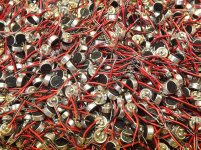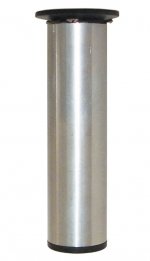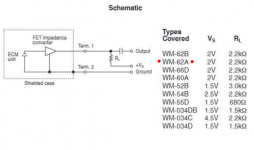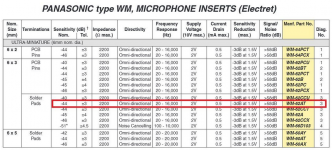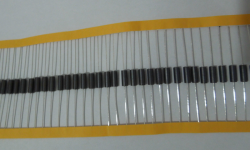Hello diyaudio!
I am not sure if it fits here but I hope as it is some kind of analog source. I have been lately reading about making my own microphone, as thinking of it they are nothing more than a hollow cilinder with a conector and the capsule.
I have bough some capsules from ebay (Panasonic WM-62A) for 1€ a piece to test them and see how they perform against commercial ones. I have one of those tubular aluminium pieces used for tables that I plan to fit with a capsule and an XLR connector.
Do you have any experience in doing microphones? any lecture recommended?
Thanks!
I am not sure if it fits here but I hope as it is some kind of analog source. I have been lately reading about making my own microphone, as thinking of it they are nothing more than a hollow cilinder with a conector and the capsule.
I have bough some capsules from ebay (Panasonic WM-62A) for 1€ a piece to test them and see how they perform against commercial ones. I have one of those tubular aluminium pieces used for tables that I plan to fit with a capsule and an XLR connector.
Do you have any experience in doing microphones? any lecture recommended?
Thanks!
Attachments
I have build one very simpel direct to unbalanced jack connector. It works fine for simple measurements.
Here are some more pro guiding on the subject
http://sound.westhost.com/project93.htm
Here are some more pro guiding on the subject
http://sound.westhost.com/project93.htm
I would like to try it both as a measurement mic (not calibrated but as kjeldsen said, should be enough for simple tasks) and as a microphone for singing. I plan on fitting the capsule with some kind of rubber to disminish the amount of vibration transmitted to it and putting a mesh and foam over it to protect it from wind noise and impacts.
For FR work I recommend a calibrated mic. Period. Uncalibrated mics can be far off from a flat response and you'll never know, maybe trying to adjust a problem that is from mic and not in the speaker.
Calibrated mic can cost some tens of €, not too expensive, IMO, just be aware of the need (or not) of a mic preamp.
I build a diy mic with a Panasonic WM-61A in the past, and it needed phantom power (easy) and a preamp, and without one it was useless for FR measures.
Ralf
Calibrated mic can cost some tens of €, not too expensive, IMO, just be aware of the need (or not) of a mic preamp.
I build a diy mic with a Panasonic WM-61A in the past, and it needed phantom power (easy) and a preamp, and without one it was useless for FR measures.
Ralf
In what sense, Ralph? Will it give better frecuency/noise performance with it? more gain maybe?For FR work I recommend a calibrated mic. Period. Uncalibrated mics can be far off from a flat response and you'll never know, maybe trying to adjust a problem that is from mic and not in the speaker.
Calibrated mic can cost some tens of €, not too expensive, IMO, just be aware of the need (or not) of a mic preamp.
I build a diy mic with a Panasonic WM-61A in the past, and it needed phantom power (easy) and a preamp, and without one it was useless for FR measures.
Ralf
please read more here
System Test
Some capsules have fine linearity, and the WM-60A I use have quite identical deviations from the reference even if 100 capsules are compared. A generic calibration file can be used. This is not the case for capsules in general, so be carefull to trust specs from the datasheets. In general the linearity below 1 kHz is good, and above it will deviate a lot.
System Test
Some capsules have fine linearity, and the WM-60A I use have quite identical deviations from the reference even if 100 capsules are compared. A generic calibration file can be used. This is not the case for capsules in general, so be carefull to trust specs from the datasheets. In general the linearity below 1 kHz is good, and above it will deviate a lot.
Thanks for your input. Not that I really care about having a perfect flat response, they will almost only be used to record voices and instruments.
I am currently using those Senn SM58, and what I expect is to get better perceived sound quality and be able to use them at the studio or in live concerts where high quality is a requierement.
Shure SM58 LC - Thomann España
I am currently using those Senn SM58, and what I expect is to get better perceived sound quality and be able to use them at the studio or in live concerts where high quality is a requierement.
Shure SM58 LC - Thomann España
For FR work I recommend a calibrated mic. Period. Uncalibrated mics can be far off from a flat response and you'll never know, maybe trying to adjust a problem that is from mic and not in the speaker.
Calibrated mic can cost some tens of €, not too expensive, IMO, just be aware of the need (or not) of a mic preamp.
I build a diy mic with a Panasonic WM-61A in the past, and it needed phantom power (easy) and a preamp, and without one it was useless for FR measures.
Ralf
+1. I've built several measuring mics using the Panasonic capsules. You can use them to measure woofers, but they vary so much with tweeters, compared to properly calibrated mics. You can get a EMM-6 mic from Cross Spectrum Labs for $75, so why build?
+1. I've built several measuring mics using the Panasonic capsules. You can use them to measure woofers, but they vary so much with tweeters, compared to properly calibrated mics. You can get a EMM-6 mic from Cross Spectrum Labs for $75, so why build?
Because almost everybody here conceive them as a measurement instrument rather than a high-end vocal mic that can be built with less than 10$. I never said my aim was to build a measurement mic, I would like to see how much vaule can I squeeze out of 10$. Can they sound the same as a 500$ one? the same as a 100$ one? the same as a 20$ one? That's the whole point of getting into diy microphones.
I my humble opinion the panasonic capsules only provide great value in the cheap region (below 100$). I would prefer an old Sennheiser MD421 anytime for vocals, and anywhere where you want to mic up close the instruments.
It's not at all bad for vocals, but it just missing some warmth. I havent been able to eq warmth in these capsules.
On a rockguitar a panasonic capsule i very thin and bright.
It's not at all bad for vocals, but it just missing some warmth. I havent been able to eq warmth in these capsules.
On a rockguitar a panasonic capsule i very thin and bright.
You can get more information and help in the "Micbuilders" Yahoo group at
http://tech.groups.yahoo.com/group/micbuilders/
Dale
http://tech.groups.yahoo.com/group/micbuilders/
Dale
Hello diyaudio!
I am not sure if it fits here but I hope as it is some kind of analog source. I have been lately reading about making my own microphone, as thinking of it they are nothing more than a hollow cilinder with a conector and the capsule.
I have bough some capsules from ebay (Panasonic WM-62A) for 1€ a piece to test them and see how they perform against commercial ones. I have one of those tubular aluminium pieces used for tables that I plan to fit with a capsule and an XLR connector.
Do you have any experience in doing microphones? any lecture recommended?
Thanks!
Long time ago I got two capsules of Primo, they were invented for measure sound systems. The diameter is 20mm, biger than any Panasonic.
I hear about them for an article in Glass Audio (I was a serious follower of this magazine) I attached a valve in the same envelope of the micro and the sound was amazing, the dynamic range of this micro is 130dB and the response is flat between 2 and 13KHz. I don't know how get again but maybe is possible.
Best Regards.
If you go to Linkwitzlab.com and look deep enough, you'll find where he used these cheap little Panasonic mic capsules in an experiment with binaural recordings. He pointed out that the built in FET preamp wasn't biased properly, and showed how he fixed that. He also shows the schematic of the mic preamp he built to procede it. After the fix, he seemed to think they were good enough for his binaural recordings (which you can buy from him on a CD). I'm guessing they were very accurate to a pretty high frequency.
My main concern with these capsules is at what level they acoustically overload, and whether or not I have access to a high end pro calibrated mic to compare it with, to verify the accuracy (I've got several). If directionality matters, I think these capsules are basically omni-directional. To get other patterns you have to have access to the back side of the diaphram, and know physics and metal machining pretty good. I've been tempted to use these as PZM mics (pressure zone mics). That's where you mount them such that the diaphram is as close to a reflective surface as is practical, the reflective surface being an entire wall of a room. As the size of the wall becomes smaller, you get a roll-off of lower frequencies. Many room acoustics problems go away with this technique. In some situations it could be far superior to other miking techniques (a bluegrass band playing in a victorian house that was converted into a pub)..
My main concern with these capsules is at what level they acoustically overload, and whether or not I have access to a high end pro calibrated mic to compare it with, to verify the accuracy (I've got several). If directionality matters, I think these capsules are basically omni-directional. To get other patterns you have to have access to the back side of the diaphram, and know physics and metal machining pretty good. I've been tempted to use these as PZM mics (pressure zone mics). That's where you mount them such that the diaphram is as close to a reflective surface as is practical, the reflective surface being an entire wall of a room. As the size of the wall becomes smaller, you get a roll-off of lower frequencies. Many room acoustics problems go away with this technique. In some situations it could be far superior to other miking techniques (a bluegrass band playing in a victorian house that was converted into a pub)..
Last edited:
I have read on Linkwitz website about the modification for those Panasonic capsules, some websites agree on it being a substancia improvement. I think I will go with this preamp, I think I can fit those boards on a tiny tubular enclosure, plus the XLR connector and the capsule.
Recording and Measurement Microphones
Recording and Measurement Microphones
On the article I link in the above post, there is an schematic I am planning to build but it is the first time I make a circuit that uses ferrite beads. From what I have read, they are some kind of a randomly used device in the sense that you buy them by size or weight, and don't have directly measurable properties (am I right?).
Is there any kind of ferrite bead I should aim to? May I pick up just whatever I see I can fit?
Those seem like a great deal, 3$ for 100 pcs., they're leaded and have a nice size for PCB mounting.
100pcs Inductor Beads 3 5 9 0 8 Axial Ferrite Beads 3 5x9x0 8 | eBay
Is there any kind of ferrite bead I should aim to? May I pick up just whatever I see I can fit?
Those seem like a great deal, 3$ for 100 pcs., they're leaded and have a nice size for PCB mounting.
100pcs Inductor Beads 3 5 9 0 8 Axial Ferrite Beads 3 5x9x0 8 | eBay
Attachments
The ferrite beads, which are inductors, act as Rf filters. They do vary but I'm not enough of an expert to tell you which type is best. It will depend on the impedance of the circuit they are put in. When I was calibrating Tektronix 475A oscilloscopes back in 1979, we had a few different types of these beads that we would put on legs of a transistor to get the step response to be right.
- Status
- This old topic is closed. If you want to reopen this topic, contact a moderator using the "Report Post" button.
- Home
- Source & Line
- Analogue Source
- DIY microphones
